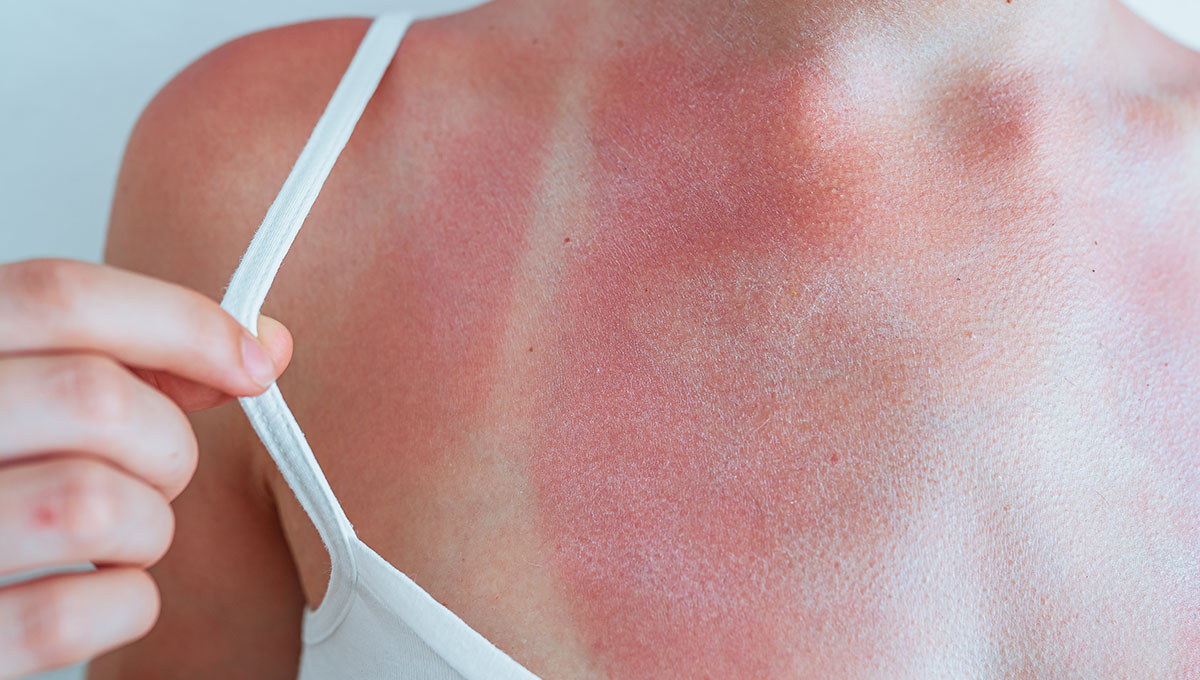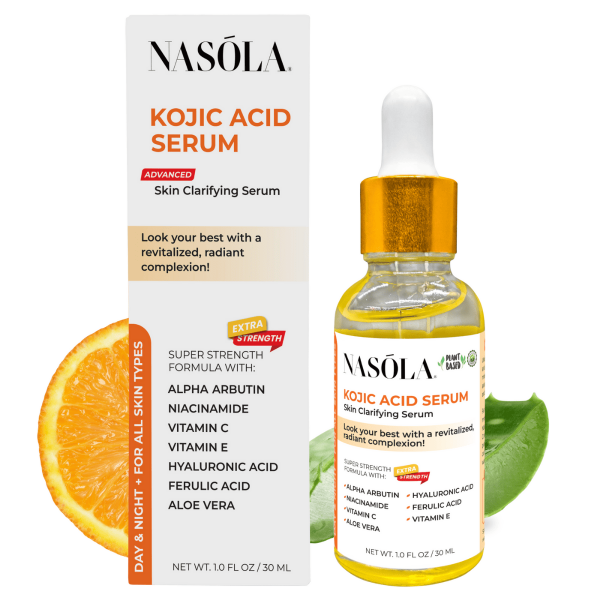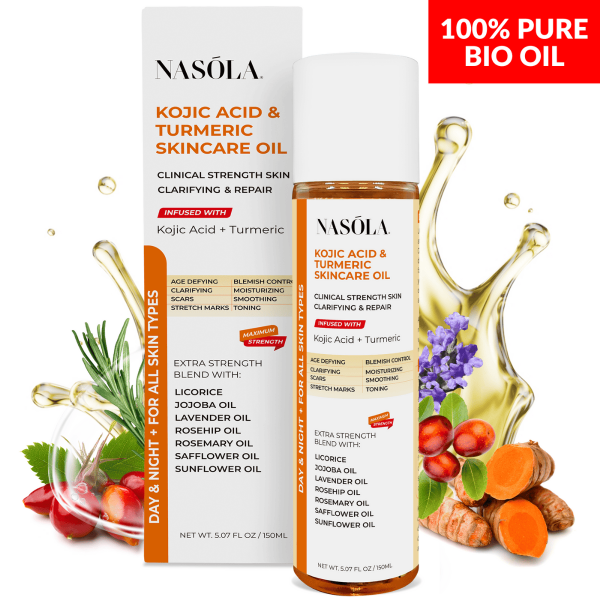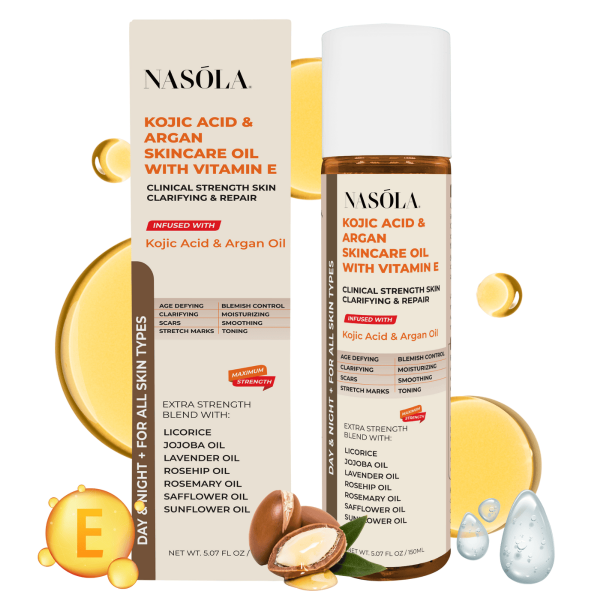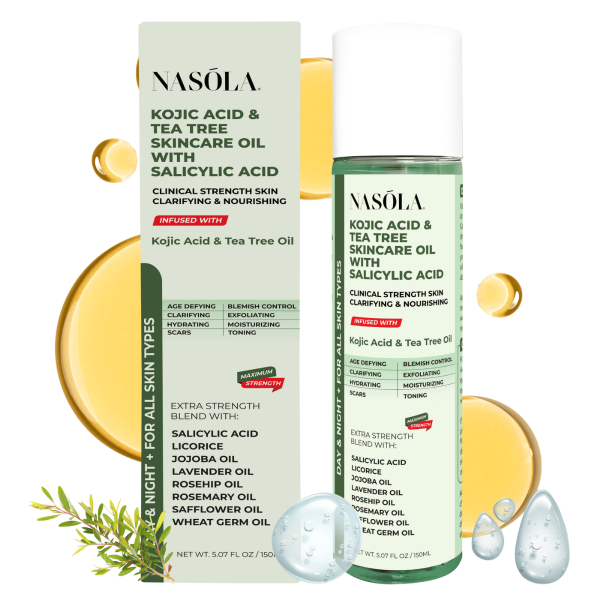If you’ve ever underestimated the sun—just for “a little glow”—and ended up sizzling like a tomato… you’re not alone. The best essential oil for sunburn doesn’t just soothe, it rewinds the damage without burning a hole in your skincare budget.
That stingy tightness, the peeling, the face that screams “I fell asleep on the beach”—ugh, it’s a mood killer. But here’s the good news: nature gave us some ridiculously magical oils that get the job done.
And when they’re fused with all-stars like retinol and kojic acid (hi, hi Nasola fam 👋), the results become nothing short of dreamy.
In this post, we’ll look at natural yet power-packed solutions—essential oils blended into smart bio oils that actually work to heal stressed, sun-worn skin.
- What is the Best Essential Oil for Sunburn?
- Essential Oil for Sunburn on Face
- Turmeric: Nature’s Golden Healer for Sunburn Relief
- How Retinol Enhances the Healing Process for Sunburned Skin
- The Role of Kojic Acid & Salicylic Acid in Post-Sunburn Care
- Choosing the Right Product for Your Skin Type
- Bonus: How Long Should You Use the Best Essential Oil for Sunburn?
- Conclusion
- Frequently Asked Questions
What is the Best Essential Oil for Sunburn?
Finding the best essential oil for sunburn means something that cools the fire, calms the irritation, and works overtime to repair.
Essential oils like lavender, chamomile, and tea tree are loaded with anti-inflammatory and soothing properties. But here’s the real kicker—these oils don’t have to work alone.
When infused with powerhouse ingredients like retinol and salicylic acid, their potential just multiplies.
Sunburns are more than surface-level redness. They nibble at the moisture barrier, spark inflammation, and, if ignored, leave pigmentation or peeling behind.
That’s where essential oils like tea tree and peppermint swoop in with their antimicrobial and cooling effects.
Especially when they’re part of a formulation meant for more than just momentary comfort—they help trigger faster skin renewal.
Nasola Kojic Acid Tea Tree Skincare Bio-Oil with Salicylic Acid
If there’s one vote for a tea-tree-forward miracle, this is it. The Nasola Kojic Acid Tea Tree Skincare Bio-Oil with Salicylic Acid carries that zingy relief of real tea tree oil, but with so much more behind it.
- Tea tree oil for antibacterial and anti-inflammatory support
- Salicylic acid to prevent clogged pores and gently shed dead skin
- Retinol to boost skin turnover and banish that infamous sun-scorch flake
- Kojic acid to fade the dreaded post-burn discoloration
This oil helps you skip the greasy mess of DIY and gives you a ready-to-go solution. Just pump it out, massage it in, and enjoy skin that starts to rebound—without the wait.
Essential Oils That Soothe Sun-Damaged Skin
Quick recap of winners when we talk essential oils to calm that burn:
- Lavender oil: Soothes swelling, redness, and stress
- Chamomile oil: Nurtures sensitive, delicate skin
- Tea tree oil: Takes out inflammation and bacteria
- Peppermint oil: Provides instant cooling comfort (especially if your skin screams “cool me down!”)
Essential Oil for Sunburn on Face

The face bears everything—UV rays, pollution, your emotions. And unlike tougher spots on your body, facial skin needs more gentleness when healing from sunburn. So when picking an essential oil for sunburn on face, you want the kind that works without creating drama.
Luckily, Mother Nature showed up with chamomile and lavender. Blend them seamlessly into lightweight, non-comedogenic oil bases, and voilà—you get the facial healer you didn’t know you needed. Let’s get into what works when your face cries SOS.
Nasola Kojic Acid Argan Skincare Bio-Oil
Now this is self-care in a bottle. The Nasola Kojic Acid Argan Skincare Bio-Oil blends gentle essential oils into argan’s naturally hydrating base.
- Argan oil, rich in essential fatty acids and vitamin E
- Kojic acid, to rescue from uneven tone or lingering sun patches
- Retinol, to nudge new skin cells to the surface without kicking up irritation
- Lavender oil, known for softening inflammation (and even helping calm sunburn insomnia)
It’s lightweight, fast-absorbing, and gives your face the TLC it needs after too much sun exposure—without clogging pores or making things worse.
Chamomile & Lavender Oils For Facial Recovery
Chamomile on the cheeks when sunburned? Yes, please.
These oils whisper healing to your skin:
- Shrinks redness and blotchiness immediately
- Ideal for people with sensitive or reactive skin types
- Offers aromatherapy benefits to unwind after a long day at the beach
- Helps protect skin’s moisture barrier and soothes raw, tender spots
When included in carefully balanced bio-oils like Nasola’s blends, chamomile and lavender deliver visible calm within days. No mystery. No stinging. Just quiet, effective softening.
Turmeric: Nature’s Golden Healer for Sunburn Relief
Turmeric isn’t just for turmeric lattes or DIY masks. It brings major healing energy to your sun-parched skin.
With its deep yellow pigment and antioxidant-stacked profile, turmeric is fantastic at cooling inflammation while working to even out your skin tone when sunburn tries to leave a souvenir.
Using turmeric as an oil versus a raw powder also means less mess and more targeted healing—especially when combined with kojic acid and retinol to fade sun spots and exfoliate gently.
Why Turmeric is Ideal for Sunburn
Let’s break it down:
- Contains curcumin, an active compound with strong anti-inflammatory properties
- Antioxidant benefits help cool residual skin damage caused by UV penetration
- It naturally supports melanin balance—ideal for fighting post-burn pigmentation
- Soothes swelling and reduces facial redness when used in oil-based applications
That yellow hue may slightly tint your hand during application, but on your skin? It’s magic. 🙌
Turmeric Products Worth Trying
A favorite of mine? The Nasola Kojic Acid Turmeric Skincare Bio-Oil.
- Power duo of turmeric + retinol combats sunspot and flake city
- Kojic acid lifts pigment gently while giving skin a brightened finish
- Nourishing oil texture seals in post-sun hydration so peeling doesn’t stand a chance
- Non-greasy formula means no more “shiny tomato” look
Sunburn gets uncomfortable quickly—but recovery doesn’t have to. Use after a cool shower, massage in gently, and feel the burn melt into relief.
How Retinol Enhances the Healing Process for Sunburned Skin

Ahh…retinol. The elixir of glow. But what many people don’t realize is how much it does to enhance the healing process after a sunburn.
Post-burn, your skin goes through a phase of cell turnover and shedding—this is where retinol steps in. It speeds it up. Instead of a two-week long battle with flaky dry patches, retinol helps you exfoliate, regenerate, and revive faster—without extra trauma.
Combating Sun Damage with Retinol
Retinol (a vitamin A derivative) offers real benefits post-sun damage:
- Boosts collagen production in stressed skin
- Promotes faster healing through gentle exfoliation
- Smooths texture and tones overall complexion after rough patches and peeling
- Helps fade red or brown spots left by severe exposure
Every Nasola skincare bio-oil we’ve mentioned contains retinol in a skin-supportive formulation, designed for after-burn recovery.
Layering Retinol Safely After Sunburn
Timing is everything here 😅
Tips for safe application:
- Wait until redness subsides—usually 2–3 days post-burn
- Start with once every two nights if skin’s still sensitive
- Avoid layering with direct acids at first
- Always follow with sunscreen the next AM (yes…even inside the house!)
Let your healing skin lead the pace. Retinol is a friend when used with patience.
The Role of Kojic Acid & Salicylic Acid in Post-Sunburn Care
Don’t just soothe the burn. Correct the aftermath.
When you’re dealing with the long game—pigmentation, patchy spots, uneven tone—kojic acid and salicylic acid tag-team those trouble zones like pros.
Faded sunburn scars? Check. Flaky dry skin? Gone. These ingredients reinstate balance in your skin long after the heat is over.
Even Skin Tone with Kojic Acid
Hyperpigmentation after a burn can take weeks to fade… unless you assist the fade.
Use the Nasola Kojic Acid Serum for targeted repair:
- Kojic acid halts melanin overproduction
- Helps undo UV-triggered dark spots and speckled patches
- Lightweight and potent for nighttime spot treatment
- Use a thin layer post-moisturizing to focus on areas picking up extra pigment
Healing is about consistency. This lightweight serum makes it so much easier.
Smooth Recovery with Salicylic Acid
Dry, patchy flakes after sunburn? OUCH.
That’s where salicylic acid comes in—exfoliation without harsh scrubbing.
- Buffs out burned rough spots calmly
- Clears blockages deep in pores from sweat + sunscreen
- Supports smoother texture post-damage
- Bonus: It’s in Nasola Kojic Acid Tea Tree Skincare Bio-Oil with Salicylic Acid already—no extra product needed!
Choosing the Right Product for Your Skin Type

Not every oil fits every skin type, especially after sun drama. Choosing an essential oil blend that matches your skin’s response is key.
If your skin leans dry, you’ll need deep moisturizers and calming ingredients. Oily or acne-prone? Go for oils that clean out and calm without adding fuel to the shine fire.
For Dry and Irritated Skin
When your skin feels like tissue paper post-sunburn?
Grab the Nasola Kojic Acid Argan Skincare Bio-Oil.
- Argan oil lavishes skin with fatty acids
- Kojic acid helps manage sun discoloration gently
- Retinol supports recovery without stripping irritation-prone areas
- Best used at night for deep rejuvenation
For Acne-Prone or Oily Skin
Oily skin can still burn—and heal fast (or badly 🫠) without proper care.
Reach for the Nasola Kojic Acid Tea Tree Skincare Bio-Oil with Salicylic Acid.
- Tea tree oil’s antibacterial edge fights clogged hair follicles
- Salicylic acid resurfaces texture safely
- Lightweight consistency avoids congestion
- Retinol + kojic acid dual action fades spots while managing tone
Bonus: How Long Should You Use the Best Essential Oil for Sunburn?
Tracking your skin’s rhythm is key when using the best essential oil for sunburn consistently. Healing isn’t a one-night act—it’s a concert of many small routines doing the work day by day.
Signs You’re On the Right Track
- Skin redness fades within 48–72 hours
- Flaking decreases with regular hydration + light exfoliation
- Pigmentation improves gradually
- Texture begins smoothing by Week 1
Non-negotiables For Results
- Apply once or twice daily post-cleansing
- Always apply sunscreen during daytime even if healing
- Stay hydrated—internal hydration affects external calm
- Avoid harsh scrubs or direct acids during sensitive stages
Conclusion
Sunburn isn’t just about discomfort. It’s damage—and deserves proper healing.
The best essential oil for sunburn works more powerfully when blended into targeted skincare bio-oils like those from Nasola.
When you combine the calming properties of turmeric, lavender, chamomile, and tea tree with skin-experts like kojic acid, salicylic acid, retinol, and argan oil, you’re not just easing the sting…you’re feeding your skin exactly what it needs to recover.
So give your skin a reset—it’s earned it.
Explore the full Nasola skincare bio-oil collection to turn your post-sun tale into one of restoration and radiance ❤️
Frequently Asked Questions
Lavender and tea tree oils are highly effective for soothing burnt skin. For safe application, opt for blends like the Nasola Kojic Acid Tea Tree Skincare Bio-Oil with Salicylic Acid, which combine these oils with salicylic acid and retinol for accelerated healing and comfort.
Yes, especially gentle oils like chamomile or argan oil blends. The Nasola Kojic Acid Argan Skincare Bio-Oil is facial-friendly, soothing, and helps even tone and reduce inflammation without clogging pores or irritating delicate skin.
Turmeric has incredible anti-inflammatory and antioxidant effects. It helps reduce swelling and redness while promoting healing. The Nasola Kojic Acid Turmeric Skincare Bio-Oil uses turmeric alongside kojic acid and retinol to fade pigmentation and replenish skin.
Wait until the redness subsides—usually 48–72 hours post-burn. Start slow with products like Nasola skincare oils containing retinol for gentle, consistent rebuilding. Always pair with sunscreen during the day.
Absolutely. Kojic acid is known for lightening hyperpigmentation and evening out skin tone. The Nasola Kojic Acid Serum is especially helpful as a concentrated spot treatment for fading sunburn scars and pigmentation.
Yes. Use Nasola’s oils after cleansing and before or in place of your moisturizer. Let it absorb well before applying sunscreen or makeup during the day.
A blended product is safer and more effective. Pre-formulated solutions like Nasola’s skincare bio-oils offer balanced concentrations of essential oils, actives, and nourishing agents without the guesswork or irritation risk.
They help! Especially oils with retinol and moisturizing bases like argan oil. The Nasola Kojic Acid Argan Skincare Bio-Oil supports skin regeneration and hydration, minimizing peeling.
Continue use for at least 1–2 weeks post-burn. The Nasola Kojic Acid Turmeric Skincare Bio-Oil is especially effective for ongoing healing and pigmentation recovery.
Once the initial inflammation settles, yes. Just make sure it’s in a balanced formulation like Nasola Kojic Acid Tea Tree Skincare Bio-Oil with Salicylic Acid, where healing and exfoliation happen side-by-side.

